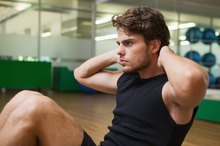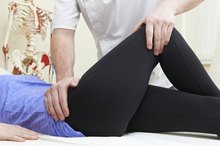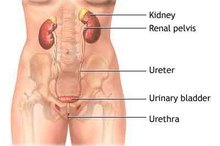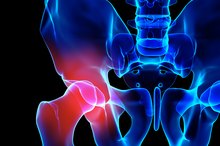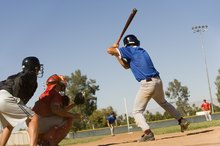What does fact checked mean?
At Healthfully, we strive to deliver objective content that is accurate and up-to-date. Our team periodically reviews articles in order to ensure content quality. The sources cited below consist of evidence from peer-reviewed journals, prominent medical organizations, academic associations, and government data.
The information contained on this site is for informational purposes only, and should not be used as a substitute for the advice of a professional health care provider. Please check with the appropriate physician regarding health questions and concerns. Although we strive to deliver accurate and up-to-date information, no guarantee to that effect is made.
Groin Pain After Golf
Although golfers often injure their shoulders or elbows, groin injuries from the torso rotation of the golf swing are also possible. This movement can even aggravate other conditions not caused by golf. See your doctor for a proper diagnosis and treatment plan if you are experiencing groin pain during or after golf.
If you are experiencing serious medical symptoms, seek emergency treatment immediately.
Sports Hernia
A possible cause of your groin pain is a sports hernia. Male hockey and soccer players are the most likely to suffer from sports hernias because of the repetitive twisting, but golfers also do a lot of twisting, making this a possible injury for them as well. A sports hernia is a weakening of the back of the inguinal wall that does not result in a hernia you can feel externally 3. The inguinal wall is an area just above your genitals. It is the deepest layer of your abdominal muscles. A sports hernia causes gradual groin pain over time that feels worse with activity.
- A possible cause of your groin pain is a sports hernia.
- A sports hernia is a weakening of the back of the inguinal wall that does not result in a hernia you can feel externally 3.
Groin Pull
Testicular Pain After Sit-ups
Learn More
A groin pull, or strain, could also be causing your pain. A groin pull is a stretching, tearing or even bruising of the inner thigh muscles, called the hip adductors. These muscles activate during a golf swing to move your hips toward the midline of your body. This movement happens first to shift your weight backward, and then again to shift forward during the down swing. Overusing the muscles or failing to warm up are the most likely causes of a groin pull in golf. Ask your doctor or golf instructor to teach you how to warm up and stretch your thighs safely.
- A groin pull, or strain, could also be causing your pain.
- These muscles activate during a golf swing to move your hips toward the midline of your body.
Osteitis Pubis
Osteitis pubis is groin pain resulting from inflammation at the point on the front of the pelvic girdle where the right and left pubic bones meet. Athletes from ice skaters to dancers are at risk for this condition, but any athlete who performs repetitive motions in their lower bodies can develop osteitis pubis. You might feel pain on one or both sides of your groin. Rest and ice might help reduce pain and swelling, but do not hesitate to consult your doctor if you feel it is necessary. An MRI or bone scan can typically confirm a suspected diagnosis.
- Osteitis pubis is groin pain resulting from inflammation at the point on the front of the pelvic girdle where the right and left pubic bones meet.
- Athletes from ice skaters to dancers are at risk for this condition, but any athlete who performs repetitive motions in their lower bodies can develop osteitis pubis.
Nerve Entrapment
Sneezing & Groin Injury
Learn More
Golfing can aggravate pain due to nerve entrapment in the groin or thigh area. Nerve entrapment is simply the irritation or compression of a nerve, possibly due to inflammation. Nerves might be stuck to the skin of the groin due to scar tissue from a recent surgery. A nerve entrapped near the front and side of your thigh could also cause groin pain or numbness. Twisting motions and situps might increase pain from these nerve issues. Your doctor might look for infections, blockages, tumors or cysts around the pelvic region, or recommend physical therapy or even surgery to fix your problem.
- Golfing can aggravate pain due to nerve entrapment in the groin or thigh area.
Related Articles
References
- Dellon Institutes for Peripheral Nerve Surgery: Groin Pain Syndromes
- AAOS: Sports Hernia (Athletic Pubalgia)
- PubMed: The Treatment of Inguinal Pain
- Shetty VD, Shetty NS, Shetty AP. Groin pain in athletes: a novel diagnostic approach. SICOT J. 2015;1:16. doi:10.1051/sicotj/2015017
- Tyler TF, Silvers HJ, Gerhardt MB, Nicholas SJ. Groin injuries in sports medicine. Sports Health. 2010;2(3):231-6. doi:10.1177/1941738110366820
- Jenkins JT, O'dwyer PJ. Inguinal hernias. BMJ. 2008;336(7638):269-72. doi:10.1136/bmj.39450.428275.AD
- Chung C, Stern PJ, Dufton J. Urolithiasis presenting as right flank pain: a case report. J Can Chiropr Assoc. 2013;57(1):69-75.
- Khan AM, Mcloughlin E, Giannakas K, Hutchinson C, Andrew JG. Hip osteoarthritis: where is the pain? Ann R Coll Surg Engl. 2004;86(2):119-21. doi:10.1308/003588404322827518
- Pun S, Kumar D, Lane NE. Femoroacetabular impingement. Arthritis Rheumatol. 2015;67(1):17-27. doi:10.1002/art.38887
- Groh MM, Herrera J. A comprehensive review of hip labral tears. Curr Rev Musculoskelet Med. 2009;2(2):105-17. doi:10.1007/s12178-009-9052-9
- Moya-angeler J, Gianakos AL, Villa JC, Ni A, Lane JM. Current concepts on osteonecrosis of the femoral head.World J Orthop. 2015;6(8):590-601. doi:10.5312/wjo.v6.i8.590
- Larson CM. Sports hernia/athletic pubalgia: evaluation and management. Sports Health. 2014;6(2):139-44. doi:10.1177/1941738114523557
- Allegri M, Montella S, Salici F, et al. Mechanisms of low back pain: a guide for diagnosis and therapy. F1000Res. 2016;5. doi:10.12688/f1000research.8105.2
- Gomella P, Mufarrij P. Osteitis pubis: A rare cause of suprapubic pain. Rev Urol. 2017;19(3):156-163.
- Bisciotti GN, Auci A, Di marzo F, et al. Groin pain syndrome: an association of different pathologies and a case presentation. Muscles Ligaments Tendons J. 2015;5(3):214-22. doi:10.11138/mltj/2015.5.3.214
- American Academy of Orthopedic Surgeons. (n.d.). Hip Fractures. https://orthoinfo.aaos.org/en/diseases--conditions/hip-fractures/
- Bisciotti GN et al. Groin Pain Syndrome: An Association of Different Pathologies and a Case Presentation. Muscles Ligaments Tendons J. 2015 Jul-Sep;5(3):214-22.
- Johnson R. (2018). Approach to hip and groin pain in the athlete and active adult. Fricker P, Fields KB, eds. UpToDate. Waltham, MA: UpToDate Inc.
- Martin RR, Martin HD, Kivlan BR. Nerve Entrapment in the Hip Region: Current Concepts Review. Int J Sports Phys Ther. 2017 Dec;12(7):1163-73.
- Wilson JJ, Furukawa M. Evaluation of the Patient with Hip Pain. Am Fam Physician. 2014 Jan 1;89(1):27-34.
Writer Bio
Sarka-Jonae Miller has been a freelance writer and editor since 2003. She was a personal trainer for four years with certifications from AFAA and NASM. Miller also worked at 24 Hour Fitness, LA Fitness and as a mobile trainer. Her career in the fitness industry begin in 2000 as a martial arts, yoga and group exercise instructor. She graduated cum laude from Syracuse University.
